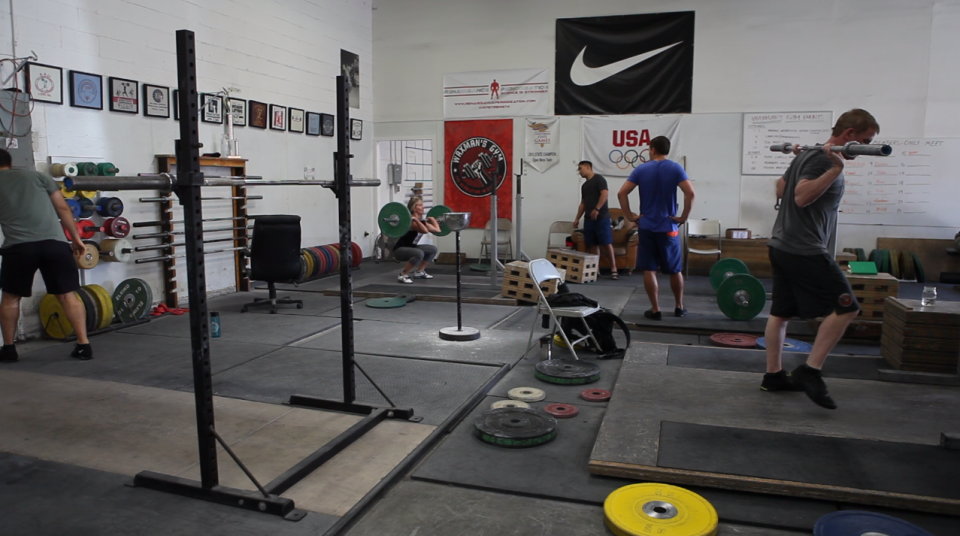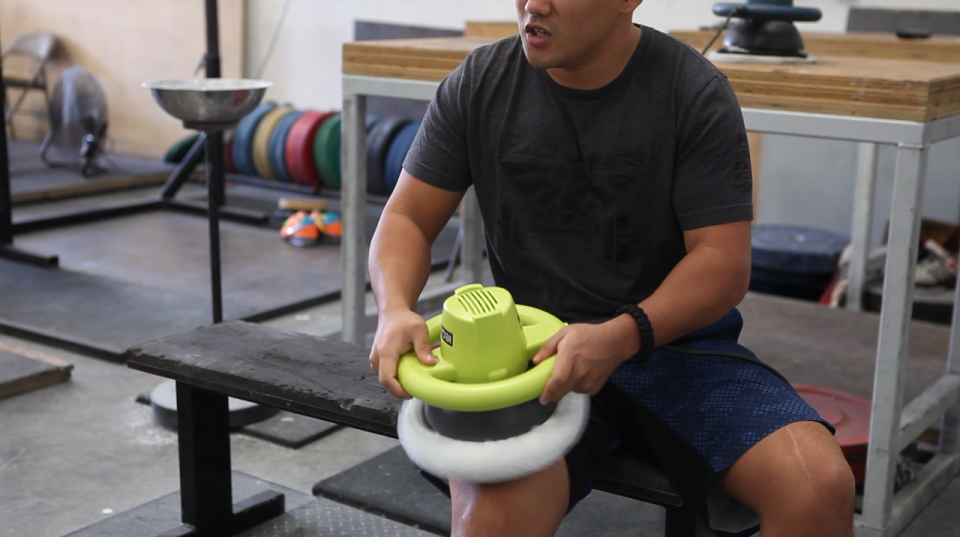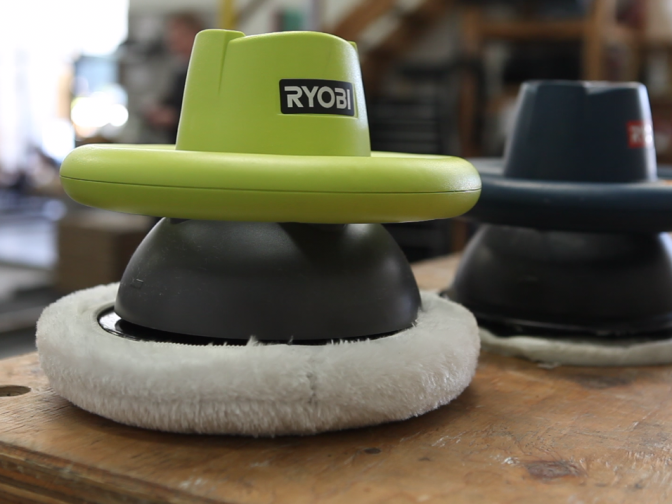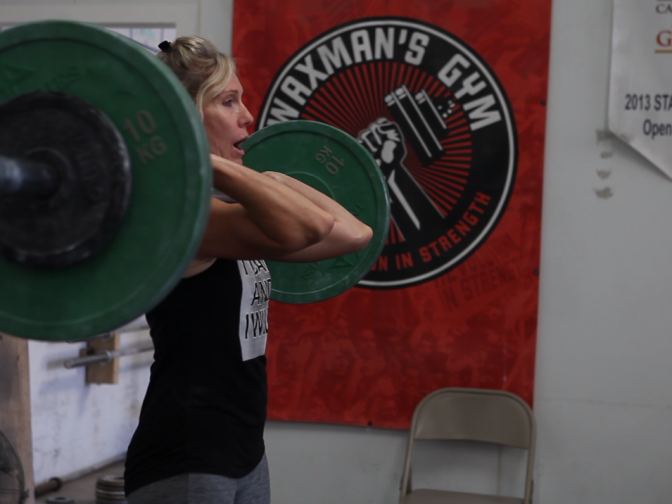Truth matters. Community matters. Your support makes both possible. LAist is one of the few places where news remains independent and free from political and corporate influence. Stand up for truth and for LAist. Make your tax-deductible donation now.
This archival content was originally written for and published on KPCC.org. Keep in mind that links and images may no longer work — and references may be outdated.
Why athletes use car buffers to massage sore muscles
The dull ache of overworked muscles is a familiar part of an athlete's daily grind. They might use foam rollers, tennis balls or — for the lucky ones — therapeutic massage to ease the pain of strenuous exercise.
But many also turn to a tool more commonly found in the garage than the gym: A car buffer.
Buffing out sore muscles
The mechanical whir of this power tool has been an accepted part of pre- and post-workout recovery for athletes for years. Online communities for strength training sports like bodybuilding, weightlifting and crossfit tout its effectiveness to their peers. Those who use them plug it in, turn it on and rub it along their legs, arms, shoulders or back to release tension.

Sean Waxman, a coach of national-level competitive weightlifters and owner of Waxman’s Gym in Lawndale, has sworn by the car buffer since he started using one to loosen muscles during hard training nearly a decade ago.
“There’s a lot of experimentation that goes on [when determining modes of recovery], and the car buffer always stands up to that test,” Waxman said.
Now, he offers it as a tool for warmup and recovery to his athletes. He says the vibration increases circulation in and reduces pain in specific areas.
“More blood gets into the muscle, makes the muscle a little more pliable,” Waxman said. “When people train hard, they’ll have aches and pains. This will help diminish that.”

The car buffer is so ubiquitous in strength training circles that you'll find one, or a similar tool, in most weightlifting gyms across the country, Waxman said. He says the buffer is effective, but a part of the reason it has been so accepted is the “athletic mindset.”
“If you tell [athletes] it’s going to get them better, they’ll do it. They don’t care,” he said. “If you tell them it’s going to make them feel better, train harder, they’ll say ‘sign me up.’”
Car buffers versus established medicine
While massage therapy has long been a proven way to treat some of the wear and tear incurred by hard athletic training, localized vibration therapy — the technique that is likely being implemented by using a car buffer — is a relatively new strategy employed by physical trainers and kinesiologists.
Aimee Diaz, an assistant professor of clinical physical therapy at the University of Southern California, said massage tools like the foam roller are an accepted way to increase mobility and flexibility in athletes. New vibrating massage tools like the TheraGun and the Hyperice Vibrating Foam Roller haven’t been thoroughly studied, but an existing study points to its effectiveness. Nevertheless, the tools are growing in clinical popularity.
“Adding vibration works with the central nervous system to calm us down, relax and lengthen the muscle,” Diaz said. “Whether that’s lasting is up for debate.”
However, few clinicians have heard of using a car buffer for the same effect. Diaz said it’s not fair to compare the industry-approved technology to the car buffer.
For starters, the car buffer hasn’t been studied as a therapy tool, so there’s no way to know if it’s effective or even safe for people in different health conditions. What’s more, buffers come in a variety of sizes, so it’s not always clear whether the buffer is the right size for the targeted area. Using a large buffer over a large area could make it less effective.
“There are a lot of variables that go into play when using a product for what it’s not designed to be used for,” Diaz said.
Cheaper than the competition
While car buffers haven’t been studied as a therapeutic intervention, there also isn’t much that points to danger.
“I haven’t seen any case studies that have actually documented someone being injured because they were using a car buffer, so I’m not sure there’s actually danger,” Diaz said. “I don’t see that it would cause any harm as long as they’re using it on themselves in a seated, comfortable position, assuming they’re not injured”
Nevertheless, Diaz and other physical therapists recommend using one of the tools that are specifically intended for localized vibration therapy like the TheraGun, a vibrating foam roll or a vibrating massage ball.
But that poses a challenge for non-professional athletes who turned to the car buffer as a low-cost alternative. Waxman discovered the buffer while he was searching for a localized massager. He came across a powerful, stainless steel device that would have set him back nearly $500.
Then he took a trip to Home Depot.
“I thought a car buffer is going to probably do the same thing. It was $20. I said, well, it’s worth a shot,” Waxman said. “I certainly didn’t invent this, I just happened to come upon it.”

The TheraGun currently sells for nearly $600, the leading vibrating foam roll costs around $200 and a vibrating massage ball can fetch around $150. In comparison, most car buffers range from $30-$50.
Diaz said it’s athletes’ prerogative to make their own financial decisions, but cautions against cutting corners on localized vibration.
“If you’re looking at everything they’re spending money on, they’re usually also paying for a high-priced gym membership,” Diaz said. “What’s the priority here?”
Waxman, and most other athletes touting the car buffer online, prefer a different tactic: Give it a shot to determine whether it’s a good fit.
“It’s relatively inert as far as hurting somebody,” Waxman said. “The only way to know if it’s for you is to try it. If you don’t like it, don’t use it.”
So should you give it a shot? It’s up to you. But you’re not going to get a doctor’s stamp of approval... for now.












